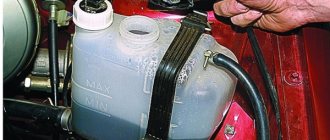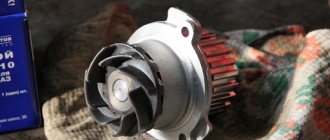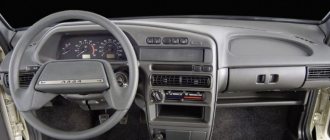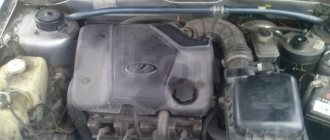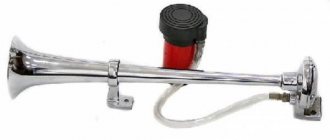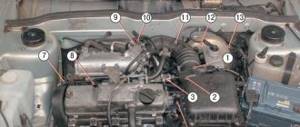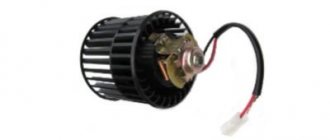The cooling system of any engine consists of two circuits - main and small. When air appears in the antifreeze, the small circuit practically stops working. The stove does not heat, and they look for the reason in the thermostat and change it, although it is necessary to get rid of the air lock. On injection engines, such as on the Lada VAZ-2114, it will be easy to expel air from the cooling system: the throttle assembly and access to it always remains open. There is also access to the expansion tank, and nothing else is needed.
If the tank is constantly swelling, this also needs to be dealt with. The video shows exactly how.
Preparation
The 11183 engine has a plastic casing that can be removed by simply pulling the part up. You can first unscrew the oil filler plug.
Motor “11183” and its protective casing
The temperature regulator in the cabin is moved to the right position. Without this, all actions will be useless.
Using method 1, the engine is first warmed up. For methods 2 and 3, the engine is left without warming up.
Do you know how to remove air from the cooling system on VAZ cars?
Welcome, friends, to the DIY car repair website. The main task of the cooling system is to reduce the temperature of the main parts of the power unit, gases and oil as quickly as possible, as well as protect the engine from overheating.
How to remove air from the cooling system
Coolant (antifreeze, antifreeze) passes through special channels, picking up heat and cooling in the system radiator. But the efficiency of the system may be impaired if there is an air lock in the cooling system.
In today's article we will look at various ways to expel air from the cooling system, as well as the causes and malfunctions of air locks.
Three different methods for removing air from the cooling system
It is always necessary to expel the air after a complete change of antifreeze!
Let's see how the throttle assembly on the 11183 engine is arranged. Antifreeze flows through hoses 1 and 3, and hose 2 is a tube with air (do not touch).
Pipes on the throttle assembly VAZ-11183
Method 1 (remove the hoses on the throttle body)
If the engine has been warmed up, remove either of the two hoses by placing a container under it. 100-200 ml of liquid may leak out . The hose is immediately returned to its place, the fastener is tightened, and antifreeze is added through the neck of the tank. “Method 1” is discussed here.
When working according to “method 1”, the tank is not opened at first. To loosen the fastening clamp, you will need a Phillips screwdriver. All manipulations with hot antifreeze are carried out with caution.
The first time the air usually comes out. But, if the procedure is repeated, the plug can be completely removed.
Method 2 (tank cap off)
The engine remains cold. Open the tank cap. Then we do it as in “method 1” (see photo).
Pipes on the throttle assembly of the VAZ-2111
As you can see, antifreeze does not leak. Let's help him a little:
- We take the tube, bring it to the tank and create an airtight seal with our fingers;
The tank is ready for use
- Blow into the tube, placing the container under the hose removed from the throttle assembly;
- If antifreeze begins to flow into the empty container, return the hose to its place;
- Tighten the fastening, add antifreeze.
This method is universal. It is used on any car, including the VAZ-2114, and it is possible to expel air from the system immediately.
Method 3 (remove air without disassembling parts)
Let's consider the simplest method. You don't have to disassemble anything:
- We place the car on an overpass or hill so that the upper part of the radiator is higher than other parts;
- Open the cap on the expansion tank;
- We start the engine. The system will warm up;
- The antifreeze level may drop abruptly. The liquid is then added.
The point is that a steam exhaust hose is connected to the radiator. Air will escape through it into the tank.
Steam outlet on the tank (do not remove!)
It will be possible to increase the engine speed, but then make sure that the antifreeze does not boil . With the cover removed, this option is not excluded!
Read more about the main reasons for antifreeze boiling on the VAZ-2114 here.
How to properly remove an air lock from the cooling system?
According to the law of physics, air accumulates in the highest place.
In a car, the highest link in the coolant chain is the throttle body. That is why the air must be removed from there. There are several ways to get rid of an air lock. Here is the first one. If you have a 1.6 liter engine, then:
- First of all, we remove the plastic cover on the engine - unscrew the cap on the engine to fill the oil, and then pull out the entire cover. It is seated on rubber seals.
- After removing this plastic screen, screw the oil cap back on to prevent dirt from getting into the crankcase.
- We find the heating pipes for the throttle assembly (there are 2 of them), see the figure. Pick up any phone.
- Next, unscrew the cap of the expansion tank (coolant reservoir) and cover the neck of the tank with a clean rag.
- We begin to blow into the tank with liquid. We blow until all the air comes out of the hose and antifreeze flows out.
- We quickly put the tube back on and tighten it with a clamp so that no air gets in.
(It is worth noting that depending on the tube that you removed, antifreeze may leak from both the tube and the fitting from which the tube was removed).
The second method of removing air from the cooling system is less perverted. There is no need to blow anything here:
- Warm up the engine to operating temperature.
- Warming up, turn off the engine.
- The expansion tank cap does NOT need to be unscrewed.
- As in the first method, unscrew the clamp of the coolant pipe on the throttle assembly.
- Having removed the heating pipe of the throttle assembly, release the air, and after the antifreeze begins to flow out, immediately put it back on the fitting and secure it well with a clamp.
But be careful and careful! Don't forget that the coolant temperature is approximately 90 degrees.
There is also a simpler, but less effective way to eliminate an air lock:
- We drive up a steep hill so that the radiator cap becomes the highest point of the cooling system.
- Unscrew the expansion tank cap and the radiator cap.
- Let the car warm up to operating temperature.
- Then we accelerate several times and at the same time add coolant into the barrel.
Do this until bubbles stop appearing.
Two important notes
When working according to method 1 or 2, the container is placed under both the hose and the throttle body pipe. It is not known which side the antifreeze will come from first. The brand of liquid is chosen as follows:
- Blue or green antifreeze can be diluted with antifreeze class G11 (green);
- Antifreeze class G12 (but not G11) can be added to red liquid.
Be careful: all antifreezes are usually sold in the form of a concentrate!
Liquid class G11
PRESENCE OF AIR IN THE SYSTEM
Air in the engine cooling system is an unacceptable phenomenon. Heat exchange processes in the motor are disrupted, which can cause it to overheat, thereby creating the preconditions for failure. In cold weather, there will be no heating of the car interior or body glazing. Sensors installed in injection engines begin to provide distorted information to the electronic control unit, which disrupts the engine’s operating cycle.
WHY DO AIR LOCKES OCCUR?
In order for an air lock to occur in the cooling system, one of several possible reasons for its occurrence is sufficient. These may be such violations in the operation of the system:
- The clamps of the rubber pipes are not tightened sufficiently, because of this, air leaks are possible, and this leads to the appearance of an air lock in the cooling system of the VAZ 2114. This is especially true for the cold season, when due to frequent temperature changes they expand and contract many times over ;
- Sticking of the valve built into the expansion tank cap;
- The seal of the water pump is broken;
- Presence of damage in the form of cracks, leaks in the main radiator or additional one for the stove;
- Burnout of the gasket between the cylinder block and the cylinder head.
Gasket burnout
Clogging of radiators or channels in the cylinder block and breakdown of pump blades can also add to the problem. The conclusion from the above is that it is necessary to immediately remove the air lock.
HOW TO GET RID?
Before you begin work on removing air from the system, a thorough inspection is necessary. Eliminate all leaks, if any, tighten all clamps on the pipes, otherwise all the work may be in vain. Make sure the “main distributor” of coolant flow is working properly, meaning the thermostat.
In order to expel air from the VAZ cooling system, there are several ways. Let's look at them:
- The first method will be as follows. Air bubbles are always lighter than any liquid, so they always collect at the top point of a closed vessel. For VAZ 2114 this will be the throttle assembly. You can remove the air plug from this unit like this. Remove the decorative engine panel to gain access to the throttle assembly. Unscrew any of the two tubes from this unit. The clamp must be left on the tube to quickly put it in place. Now you need to create excess pressure in the additional tank. This can be done by supplying compressed air to the expansion tank using any available method. It will displace antifreeze from the tank, which in turn can remove air from the system. Some sources recommend blowing into the neck of the expansion tank. It is undesirable to do this, because antifreeze or antifreeze are highly toxic substances, and their entry into the body can cause serious harm. As soon as antifreeze or antifreeze appears from the tube or pipe, quickly put everything in place and tighten the clamp well;
- Removing air from the cooling system using the second method has some similarities with the previously described method. You can bleed air like this. You need to put on gloves and with the engine well warmed up, disconnect the pipe from the throttle assembly; there is no need to open the cap on the additional tank. Bleed the air, make sure that coolant is flowing from the pipe or pipe, and put everything back in place;
- The time has come to consider the next method of how to remove an air lock from the engine cooling system. In this case, you need to position the car so that the expansion tank is the highest point in the system. With this method, it is advisable to have an assistant. Open the cap on the expansion tank and warm up the engine. When the operating temperature is reached, the assistant performs a re-gas several times, and at this time it is necessary to add antifreeze or antifreeze to the tank. It should not be allowed to remain completely without liquid. Do this until all the air is bled from the system.
The third method is good for car owners with an electronic gas pedal. With this scheme, there is no cooling of the throttle assembly, so the air plug is removed using any available height.
I would like to hope that this article will be useful to owners of not only VAZ cars and will help them get rid of air jams in the engine cooling system.
Articles
- 21110-1008650-00 – plastic screen (only for 11183);
- 21120-1008658-00 – rubber screen pin;
- 21080-1311065-00 (-01, -03) – expansion tank plug;
- 21080-1311067-00 – gasket for the plug.
Do you only need distillate?
We tried to expel air from the system, but on the VAZ-2114 the entire “plug” takes up 100-150 ml. This means you don’t have to add anything at all to the tank. You can also add regular distilled water.
It is easier to find a 100 ml package of distillate at a pharmacy or battery store.
How to bleed air from the VAZ 2114 engine cooling system
Malfunctions that occur in the ODS can significantly ruin the life of the driver. For example, when an air lock forms in the cooling system, well-heated air stops flowing into the cabin due to the fact that antifreeze does not flow into the heater stove. The engine cools worse and there is no normal heat exchange in the system. As a result, the entire internal combustion engine or individual units overheat, which reduces the life of the power unit. The operation of some sensors is distorted, which also negatively affects the overall condition of the car.
Why do air pockets form in the cooling system? There are several reasons:
- There is suction in the system due to loose pipes. This happens more intensely in winter. At low temperatures, plastic shrinks, and if the clamps are not tightened in time, then a plug in the cooling system is guaranteed;
- the valve on the expansion tank cap may be faulty;
- the seal of the pump is broken;
- cracks or leaks have appeared on cooling or heating radiators;
- A cylinder head gasket failure was discovered.
More serious reasons are possible, such as:
- clogging of radiators or pipes, as well as some mechanical damage to them;
- deformation or breakage of the pump impeller;
- partial thermostat failure;
Before removing the air lock from the cooling system of the VAZ 2114, it is necessary to thoroughly diagnose it for blockages, breakdowns and leaks. This must be done so that the work done later is not in vain. In addition, it is necessary to check the functionality of the thermostat. If it turns out to be completely or partially faulty, you can clean the system of air as much as you like, it will not work better.
Before starting work, you need to prepare antifreeze for adding to the system, if necessary. Also, rags and, preferably, two pairs of gloves - cotton, work and household, rubber. You have to work with an aggressive liquid, especially one heated to 80-90 degrees.
There are several options for removing air from the engine cooling system.
- An air lock forms at the top of the system. On a VAZ 2114 this is a throttle assembly. To get to it, you need to remove the cover covering the engine from above. After this, one of the two cooling system tubes suitable for the remote control is disconnected. The clamp must be left on it so that later you can put it back on and seal it as quickly as possible. Remove the cap from the expansion tank and, covering the neck with a thick rag, insert the pump and create pressure in the tank to remove the air lock in the cooling system. After antifreeze flows from the disconnected tube, you need to quickly put it in place and secure it.
Some experts recommend blowing into the neck of the tank to squeeze out antifreeze, but this cannot be done for two reasons. The main thing is that antifreeze or antifreeze is a toxic poison for the human body, and secondly, in order to blow effectively, you need to strain, and such “exercises” are of little use to anyone and can cause spasms.
- Another option for removing air from the VAZ 2114 cooling system is as follows.
Without removing the pipe from the throttle assembly, and without opening the expansion tank cap, warm up the engine well. After this, having previously put on gloves, disconnect the pipe from the remote control and allow the air to escape before the hot antifreeze flows out. Immediately replace the tube and fasten it securely.
- And the third option is how to bleed air from the cooling system on a VAZ 2114.
In this case, you need to take an assistant. The car is placed on an overpass or hill with the front end facing up. The radiator and expansion tank caps are unscrewed. After this, antifreeze is poured into the expansion tank to the top. The partner starts the engine and warms it up by periodically revving up to 3500 rpm. As necessary, antifreeze is added until the air bubbles disappear. The lids are closed. The machine is ready for use.
Airing the cooling system of the VAZ 2114
The appearance of an extraneous sound, gurgling of liquid, indicates air entering the device that supplies coolant to heated engine parts and removes excess heat. This condition can lead to corrosion and a decrease in the operating time of the vehicle.
To eliminate this phenomenon, it is necessary first of all to check the condition of the entire system that ensures normal thermal conditions for the engine. Make sure that the engine housing, water pump, and fluid transfer tube connections are fully tightened. If necessary, change the hose and secure the loose bolts thoroughly.
Inspect the part that insulates the detachable parts of the engine and check that it is not blackened. Traces of blackness near the gasket indicate that exhaust gases have entered the cooling system due to burnt-out valves. In this case, you need to replace the cylinder head or the entire block.
How to remove air from the cooling system of a VAZ Kalina
At low temperatures, at idle, the heating stove begins to work normally only after increasing engine speed. A splash of water appears under the instrument panel. These are symptoms of an air lock in the cooling system. Before eliminating it, it is necessary to check the connections of the pipes, tighten or replace the clamps. Pay attention to the coolant level in the expansion tank. It must be filled to capacity.
It is necessary to check the functionality of the tank plug designed to receive excess liquid that occurs during thermal expansion as a result of heating. If it is difficult to operate at the air inlet, it is replaced. It would be a good idea to check for leaks in the interior heating radiator.
How to properly eliminate existing air
The operation of automobiles has accumulated many recipes for repairing numerous faults. There are proven tips for eliminating air trapped in the system:
- Remove the cap from the expansion vessel. We squeeze the radiator hose with our hands, which leads to the removal of the air plug. After this, replace the cover.
- We check the working condition of the cylinder head, pump, hose connections. If necessary, eliminate sources of air ingress.
- After removing the cap from the radiator without turning off the engine, you need to wait until the air is completely removed from the cooling system. The existing heater should be turned on to the highest temperature.
- Add the required amount of coolant solution to the radiator, expansion tank.
If there are domestically produced cars (VAZ 2114, five-door, with a rear door and window 2114, 2109, 2110, 2107) equipped with an engine up to 1.6 liters, then for such an operation, suitable for the entire line of Tolyatti cars, the following is recommended:
- you need to remove the plastic cover on the engine, the heating tube for the gas pedal connection;
- Unscrew the heating hose clamp, remove the hose from the fitting;
- Unscrew the lid of the coolant container and cover it with a clean piece of cloth;
- blow through the expansion tank with your mouth until antifreeze appears from the pipe or throttle assembly;
- put the hose in place and tighten it with a clamp. As a result, the air is completely removed and the engine runs flawlessly.
Car enthusiasts and professional drivers most actively use other methods to solve the problem:
- the car is installed on a sloping surface so that the radiator cap is above all components of the car;
- the engine warms up to a temperature exceeding eighty degrees; then it is turned off, the clamp of the coolant pipe of the throttle assembly is unscrewed;
- the engine warms up again to the required operating temperature;
- re-gassing is carried out with the simultaneous addition of coolant into the vessel until air bubbles are eliminated there.
- the removed pipe is freed from the available air, put on the fitting and secured with a clamp.
How to remove an air lock in the engine cooling system
Before moving on to the process of removing air locks from the cooling system, let's start with the main reasons why they appear.
- First of all, it is worth mentioning depressurization as a result of broken connections of tubes, hoses and pipes. All this leads to the system sucking air through leaks at the joints. Air plugs also form when antifreeze/antifreeze is added.
- It is also worth highlighting malfunctions in the operation of the air valve. As you know, when heated, the antifreeze in the system expands and the pressure increases, but when it cools, the valve is responsible for equalizing the pressure. If the pressure is low, the valve allows air from outside. If there is a problem with this valve, excess air accumulates in the system.
- Sometimes the pump seals stop sealing the system, which leads to air leaks. Also, antifreeze can leak, its volume naturally decreases and excess air accumulates.
So, having dealt with the reasons, let’s move on to the consequences and signs that the cooling system is airy. Let us note right away that the consequences can be quite serious. An air lock can disrupt the circulation of antifreeze, especially if the air does not allow coolant to pass into the radiator. As a result, the motor overheats.
Also, the heater in the cabin begins to work poorly, which reduces comfort when using the vehicle in winter and can pose a threat to the health of the driver and passengers. To solve the problem, you need to know how to remove air from the engine cooling system. At the initial stage, you should make sure that the antifreeze level is normal, and that the cooling system itself is sealed, that is, there are no leaks.
To do this, you need to inspect all rubber parts, hoses, pipes, fittings, etc., and with the engine running. Detection of a leak will require immediate repair. If there are no leaks, but the engine overheats or, conversely, remains cold for a long time, you need to check the thermostat.
It often happens that the device jams in the open or closed position (coolant circulates only in a small or large circle). Less commonly, the reason is that an air lock has formed in the thermostat area.
How to remove an air lock: methods
As mentioned above, the most reliable and common sign of an air lock is cold air from the stove, while the engine is completely warmed up. To get rid of air in the system, there are several available methods (depending on the type of internal combustion engine, the implementation features of its cooling system, etc.).
You can ventilate the cooling system by removing the pipes through which coolant is supplied to heat the throttle. To do this, remove the plastic cover from the motor, after which free access is opened. Having found the pipes, you need to remove one of them.
Then the cap of the expansion tank is unscrewed, then a clean rag is placed on the neck, then you can blow into the tank. At the same time, do not allow coolant to get into your eyes, onto open skin or inside! Antifreeze and antifreeze are the strongest poison!
The tank should be blown out until antifreeze flows from the removed pipe. Next, the removed tube must be secured in its place, if necessary, add coolant and screw on the tank cap.
The next method is somewhat simpler than the previous one and is similar to it. First, warm up the engine and then turn off the engine. In this case, there is no need to unscrew the cap of the expansion tank.
It is enough to simply remove one of the pipes on the throttle and wait until coolant flows from there. Next, you need to secure the pipe tightly by tightening it with a clamp.
It is important to take into account that the antifreeze/antifreeze leaking from the pipe can be very hot, so you need to be careful not to get burns or injuries
Next you will need to unscrew the radiator/expansion tank caps. Then the engine is started and allowed to warm up. During warming up, you need to heavily accelerate it in several approaches, while monitoring the coolant level in the tank and topping it up. This procedure must be continued until the air bubbles disappear. Then all the plugs can be tightened.
We expel air from the cooling system on a VAZ-2114
Before removing the plug from the VAZ 2114 cooling system, it is necessary to diagnose the entire system. Excessive mechanical blockages or leaks in the system can reduce the work you have done to zero. After checking the integrity, you should test the thermostat.
IMPORTANT! Even if it is not completely faulty, and sometimes it works, there is not the slightest point in topping up and getting rid of air - the SOD will still not work.
There are several options for solving the problem when air appears in the cooling system on a VAZ 2114. You will have to choose yourself, but it all depends on your specific circumstances and skills.
First option
The method is somewhat unusual, but quite working for all models of the Soviet automobile industry, including the VAZ 2114.
In order to remove the air lock you must:
- Unscrew the oil filler neck on the engine.
- We remove the plastic protection from the rubber bands and close the lid back so that while you remove the air, mechanical dirt does not appear in the engine.
- Disconnect the tube leading to the throttle (you can choose any one).
- Unscrew the neck of the expansion tank.
- We grab the neck with our mouth and blow into it to build up pressure in the tank.
- As soon as coolant flows from the previously removed tube, put it in place and immediately tighten the clamp to prevent air from entering the system (it may not work the first time, so try).
- We put back all the previously dismantled parts.
Second option
It is logical that not everyone likes to blow into the expansion tank, especially if not water is used as a coolant, but antifreeze or antifreeze. Therefore, there is another method that does not involve inhaling harmful fumes.
- It is necessary to warm up the car to 90 degrees and immediately turn it off, not allowing it to cool down by reducing the speed and activating the fan.
- Similar to the first method, we twist one of the tubes leading to the throttle and wait.
- First, air will flow, and then antifreeze will begin to flow under pressure.
- It is at this moment that it is necessary to mount the tube in place and tighten the clamp.
This method may seem simpler and less harmful, but this is not entirely true, because you must fulfill a number of safety conditions so that the car repair does not end in a hospital bed.
When using this method, remember:
- never open the expansion tank in a hot car, because the temperature of the vapor is so high that if you perform this operation with your bare hand, the skin on it will most likely instantly cook;
- do not hold the disconnected tube with your hand, because of the splashes you will not be able to put it back on, much less tighten the clamp, because the pressure will push the practically boiling coolant through all possible cracks;
- Prepare in advance, wear thick clothing, do not forget about gloves and the tool with which you will hold the tube, the machine cools down quickly, so you will only have a few minutes to carry out the procedure after the machine stalls.
Third option
What remains is the simplest, but least effective method of how to remove an air lock in a VAZ 2114. It is very easy to do but only helps in half the cases (it all depends on where exactly the air is in the system).
To use it you will need an overpass or a small slide:
- We drive onto a hill so that the hood of the car is higher, and choose an angle such that the radiator cap becomes the highest point of the SOD.
- Remove the caps from the radiator and tank necks.
- We warm up the engine and accelerate, not forgetting to add coolant to the system.
- When the liquid stops bubbling, the work is considered complete.
How to remove air from the brake system of VAZ 2114, 2115, 2113
Air can get into the brake system and this is highly undesirable. Since air pockets form in the brake fluid circuit, which leads to the fact that the brakes may not work at any time, this is very dangerous and scary. Just imagine the situation when you are driving along a pass and descending from it, and your brakes fail, it’s a terrible thing. In general, you should monitor this very carefully, and if air does get into the system, it should be vented.
This operation is also carried out when changing the brake fluid.
In order to bleed air from the brake system, you need to bleed the brakes. One of the telltale signs that air has entered the brake system is a longer stroke of the brake pedal.
Before you start bleeding air from the brake system, you should make sure that all components of the system are sealed, since the cause must be eliminated first, and only then the effect.
Let's move on to bleeding the brakes.
Unscrew the brake fluid reservoir cap and add fluid to the maximum mark.
Air from the system should first be removed from the primary circuit, and then from the second. You need to start with the rear brake wheel cylinders.
To do this, you need to put a rubber hose on the head of the fitting, after which the free end should be lowered into a colorless container, which is slightly filled with liquid. It is convenient to perform this operation with a partner. You should repeat the same operation several times: sharply press the brake pedal with pauses of 3-4 seconds, at this time your partner unscrews the fitting by ½ - ¾ of a turn when the pedal is pressed, the liquid in the system is poured into the vessel along with the air , and do not release the brake pedal! As soon as the liquid stops flowing through the hose, and by this time the pedal is pressed to the floor, you should screw the fitting into place. This operation should be repeated as many times as possible until no more air bubbles are released. You should also monitor the brake fluid level in the reservoir and top it up.
After the operation is completed, you should wipe the fitting and put on the protective cap. This action should be performed on all wheels, and this should be done in pairs.
How to remove air from the heating system of a VAZ, air in the stove Repair and service
Author KakSimply!
With the onset of cold weather, many owners of VAZ cars have problems with the operation of the heating system. In this case, the stove either heats poorly or does not heat at all, and cold air blows from it. A possible cause of the malfunction may be an air lock in the heating system.
You will need
- — instructions for repairing a VAZ car;
- — coolant: antifreeze or antifreeze.
Instructions
To make sure that the cause of the heater malfunction is an air lock, try the heater radiator - in this case it should be hot. If this is not the case, look for a breakdown elsewhere.
After making sure that there is air in the heating system, try to drive your front wheels onto some hill, hill or overpass and leave the engine idling at medium speed for several minutes.
If the previous method did not produce results, disconnect the pipe from the throttle assembly, which goes to the return line. Fill the reservoir with antifreeze or antifreeze. If the coolant immediately runs out of the fitting of the throttle body pipe, then plug the fitting and hold until the antifreeze runs out of the hose.
If the fluid does not flow out immediately, start the VAZ and close the hose with your finger. Wait until coolant flows out of the pipe. After the work has been done, put the pipe back on and loop it. Warm up the internal combustion engine to operating temperatures and check the stove.
After filling the system, press all the hoses well and screw the expansion tank cap as tightly as possible. This will prevent coolant, which has expanded after heating, from flowing out of the holes left, and air bubbles from penetrating inside the expansion tank.
Rapid filling of the heating system with water often causes the formation of air locks: gas bubbles enter the utilities along with the water. There are several ways to remove air accumulated in the heating network.
You will need
- - pressure gauge
- - locksmith's tool
Instructions
Video on the topic
https://youtube.com/watch?v=P7lB2DtGd2w
note
Monitor the water pressure in the heating system. A drop in readings may indicate a leak, and uneven temperature conditions in the radiators may indicate the presence of air pockets. If the filling is slow and the heating system is started correctly, the deaeration procedure will not take much time.
Helpful advice
The heating system on one floor fills up in an hour on average. The duration depends on the structure and length of the communication: the more extensive it is, the more time it will take.
An article about you, published in the online magazine “We Build It Yourself.”
Video on the topic
https://youtube.com/watch?v=A4UXEZxXzOI
note
Problems with the heater may directly relate to the engine cooling system. The stove does not warm up if the coolant level in the expansion tank is low. Check carefully to see if there is an antifreeze leak in the system. If this is the case, fix this problem as quickly as possible, otherwise all your efforts will be wasted and the air lock will reappear in place of the escaped fluid.
Helpful advice
If after these manipulations the stove is still warm and not hot, repeat the procedure, adding more coolant to the normal level.
- Repair of stove (heater) VAZ 2110
- plug in the stove
Is the advice useful?
How to remove air from the heating system of a VAZ
Didn't get the answer to your question? Ask our expert:


